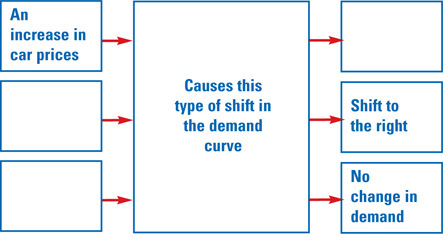Chapter 4 Assessment
Chapter Summary
A summary of major ideas in Chapter 4 appears below. See also the Guide to the Essentials of Economics, which provides additional review and test practice of key concepts in Chapter 4.
-
Section 1 Understanding Demand (pp. 79–83)
Demand describes the ability and desire to buy a good or service. The law of demand says that the quantity demanded of a good will fall as the good's price increases. Two possible responses to a change in price, the substitution effect and the income effect, work together to create the law of demand. You can list demand for a good at all possible prices in a demand schedule and chart these points on a demand curve. Every individual has a demand schedule for a good, and you can find the demand schedule for the entire market by adding up all individual demand.
-
Section 2 Shifts of the Demand Curve (pp. 85–88)
A demand curve shows demand when price varies, but all other factors stay the same. When other factors change, the demand curve shifts to the left or to the right. When a rise in income leads a consumer to increase consumption of a good, that good is a normal good. If a higher income leads to lower consumption of a good, it is called an inferior good. Other factors that can affect demand are changes in population, tastes, and the prices of other goods.
-
Section 3 Elasticity of Demand (pp. 90–96)
Elasticity of demand describes how strongly buyers will react to a change in a good's price. When demand is elastic, buyers will make relatively big changes to their consumption of a good when its price rises or falls. When demand is inelastic, consumers will only change their consumption slightly relative to the change in price. Demand will be more elastic if the good has many substitutes, is considered a luxury, or accounts for a large share of the buyer's income. Entrepreneurs can estimate the elasticity of demand for some goods and use this number to make pricing decisions.
Key Terms
Complete each sentence by choosing the correct answer from the list of terms below. You will not use all of the terms.
- normal good
- complements
- income effect
- demand curve
- inelastic
- inferior good
- law of demand
- unitary elastic
- elastic
- elasticity of demand
- You would refer to a(n) _____ to find the quantity that a person would purchase at each price that could be offered in a market.
- For a(n) _____, a consumer's demand will increase as his or her income increases.
- The _____ occurs when an increase in price decreases a consumer's real income.
- Demand for goods that are necessities is usually _____.
- If the elasticity of demand of a good is equal to 1, it is described as _____.
- According to the _____, when prices increase, quantity demanded will decrease.
- Two goods that are bought and used together are _____.
Using Graphic Organizers
-
On a separate sheet of paper, copy the multi-flow map below. Organize information on shifts in the demand curve for cars by completing the multiflow map with possible causes and effects for shifts in the demand curve.





